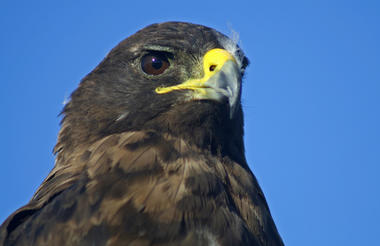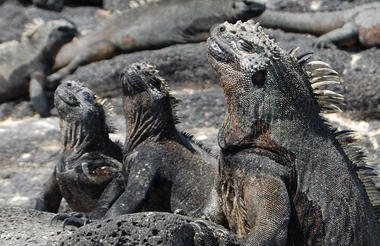In the morning, you’ll take an early flight from Quito to Baltra Island, with a short stop in Guayaquil to pick up more travelers. After landing, you'll pass through Galapagos National Park inspection, where your guide will greet you with a sign showing the name of your yacht.
You’ll take a short bus ride to the dock, learning a bit about Baltra’s history as a U.S. military base during World War II. From the dock, you’ll hop on a panga (small boat) for a quick ride to the Grace, your home for the week. The crew will bring your luggage to your cabin, while you get settled in and join your guide for a safety briefing. As the Grace begins cruising, your adventure begins.
In the afternoon, you’ll land at Las Bachas on the north end of Santa Cruz Island. These white coral beaches are known for nesting sea turtles and flocks of blue-footed boobies. A short walk inland brings you to a lagoon where flamingos, herons, and other birds gather.
You’ll have time to swim or snorkel right from the beach in warm, clear waters filled with tropical fish. Afterward, return to the Grace to relax and enjoy the evening onboard.



In the morning, you’ll visit Tower Island (Genovesa), also called Bird Island for its incredible birdlife. Your first stop is Prince Philip’s Steps, where you’ll climb up to a rocky plateau filled with red-footed and masked boobies, petrels, and maybe even a short-eared owl. After the hike, you’ll snorkel along the cliffs in the calm waters of the caldera, spotting large tropical fish and maybe a sea lion or two. Kayaking or paddleboarding is also an option here.
In the afternoon, you’ll land on the white coral beach of Darwin Bay, where frigate birds, herons, and marine iguanas fill the shore. A walk past tide pools leads to a cliffside lookout with nesting swallow-tailed gulls. Later, enjoy a scenic panga ride along the cliffs to spot red-billed tropicbirds, or go deep-water snorkeling — sometimes manta rays or even hammerheads pass through the area.
As the sun sets, watch the water — you might catch a glimpse of a giant manta ray before Grace sails west for your next adventure.



In the morning, you’ll explore Puerto Egas on Santiago Island’s northwest coast. Landing on a black sand beach, you can follow trails to salt-crusted craters, lava grottos home to fur sea lions, or inland lagoons where flamingos and hawks may be spotted. Keep an eye out for marine iguanas and woodpecker finches, and enjoy the amazing light for photos.
You’ll also snorkel from the shore, where sea turtles blend with the rocks, and rays or sea lions may glide by in the shallows.
In the afternoon, you’ll land at Espumilla Beach, a peaceful spot for birdwatching. A short walk takes you past mangroves and a lagoon where flamingos and pintail ducks feed. The trail loops through a dry forest with finches and vermilion flycatchers.
Nearby Buccaneer Cove offers stunning views of rock formations like the Monk and Elephant Rock, and it's a great place for kayaking beneath the cliffs while seabirds soar overhead.



Morning
You’ll visit Punta Vicente Roca on the northern coast of Isabela Island. This beautiful spot sits on the edge of a collapsed volcano, forming two turquoise coves. You’ll take a panga ride along the cliffs, exploring a sunken cave and spotting blue-footed and masked boobies, flightless cormorants, and sea lions. The protected coves and cold-water currents make this one of the best places for deep-water snorkeling. You might see sea turtles, rays, sea lions, and even manta rays. One hidden cove is only reachable through an underwater passage where sea lions like to rest on the beach. After your visit, the Grace heads south across the Bolívar Channel — a great place to watch for whales.
Afternoon
You’ll explore Tagus Cove, once a hideout for pirates and whalers. A panga ride along the cliffs reveals nesting penguins, cormorants, pelicans, and blue-footed boobies. You’ll then hike up a wooden staircase to Darwin Lake, a round saltwater crater just above sea level, with amazing views of the nearby volcanoes. Back in the water, go snorkeling in the green algae-covered cove, where sea turtles and marine iguanas graze. You might also see penguins swimming past, or even spot a camouflaged seahorse or Port Jackson shark. Kayaking and paddleboarding here are also great ways to enjoy the cliffs and seabirds above.



Morning
You’ll visit Punta Espinosa on Fernandina Island, the youngest and most untouched island in the Galapagos. After a dry landing, a walk takes you past marine iguanas piled on lava rocks, sea lions in tide pools, and flightless cormorants near the shore. Penguins dive from the cliffs, and colorful crabs scatter along the black lava coast. Overhead, Galapagos hawks keep watch, and sea turtles glide through quiet mangrove lagoons.
Next, enjoy snorkeling in the cool, clear waters just off the point. You might swim with sea turtles, marine iguanas, penguins, sea lions, and even spot a flightless cormorant underwater. The rocky seabed and ocean troughs are also great places to find rays and fish—and if you're lucky, dolphins or even whales passing through the Bolívar Channel.
Afternoon
After lunch, you’ll land at Urbina Bay, at the base of Isabela’s Alcedo Volcano. This beach rose from the sea in 1954, lifting coral and sea life high above the tide. Today, you can walk among exposed coral beds and maybe spot giant land iguanas with bright yellow skin and, in the wet season, giant tortoises.
The beach is also a nesting site for sea turtles. You can relax on shore or go snorkeling with tropical fish hiding near the rocks.
As the sun sets, you’ll enjoy views of Fernandina and Isabela’s massive shield volcanoes while anchored in the Bolívar Channel—one of the best spots in the Galapagos to watch for whales and dolphins.



Morning
Continuing south along Isabela’s west coast, we enter Elizabeth Bay, home to a colony of Galapagos penguins on a rocky islet. The impressive Sierra Negra volcano towers to the south—its 2018 lava flows still fresh in memory.
Elizabeth Bay’s calm waters, lined by mangrove roots, resemble a giant aquarium. Here, you’ll spot spotted eagle rays, golden rays, sea turtles surfacing to breathe, and sometimes a Galapagos hawk overhead. At the bay’s back, sea lions rest on mangrove branches, earning the nickname “tree lions.”
Afternoon
After lunch on the Grace, we head to Punta Moreno, a lesser-visited site with fresh lava fields from Sierra Negra’s 2018 eruption. Hiking here requires sturdy shoes as you cross sharp, broken lava fields.
Look for Galapagos penguins, flightless cormorants, and reddish marine iguanas along the coast, as well as colorful Sally light-footed crabs. Natural pools along the way provide oases for birds like flamingos, gallinules, and pintail ducks.
The trail leads to coastal lagoons with mangroves where pelicans nest. Keep an eye out for resting white-tipped reef sharks, green sea turtles, and great blue herons. Snorkeling here reveals sea turtles, stingrays, sea lions, parrotfish, angelfish, and schools of surgeon and creole fish.



Morning:
We visit Las Tintoreras, home to colonies of sea lions, Galapagos turtles, iguanas, skates, sharks, penguins, sea cucumbers, and urchins. The peaceful interactions among these creatures make you wonder who is really watching whom. Next, you can choose between exploring Cuevas del Sucre, fascinating lava caves and tunnels within an endemic forest, or visiting Sierra Negra Volcano.
For those who choose the volcano, we’ll travel by car to Isabela’s highlands and begin a hike into a new geological world. Along the way, you’ll enjoy stunning views and the striking contrast between volcanoes and sea, culminating at the edge of Sierra Negra’s massive volcanic crater — the second largest active crater in the world. If you wish, the hike can continue to Chico Volcano, where vibrant reds, oranges, yellows, and blacks paint a unique landscape, complete with fumaroles and impressive lava formations.
Afternoon:
We’ll visit the wetlands, home to a hypersaline lagoon frequented by flamingos and other shorebirds, before enjoying some leisure time on the beautiful beaches of Puerto Villamil.



Breakfast
Lunch
Dinner
Morning
We say goodbye to the Grace and take a 40-minute bus ride to visit Los Gemelos. These two large sinkhole craters, formed by collapsed lava tubes, mark where the tortoise’s terrestrial world meets the lava tube underworld. The contrast between the dry marine desert coast and the lush highlands is striking, and you might even experience rain here while it’s sunny at the coast.
Surrounded by a unique Scalesia forest, which is endemic to the Galapagos, Los Gemelos is home to many native species. It’s an excellent spot to see some of Darwin’s finches and the elusive vermillion flycatcher.
After exploring Los Gemelos, we continue by bus for 20 minutes to the Itabaca Channel. From there, we cross the channel and take a short bus ride to Baltra Airport to conclude our journey.



Breakfast







